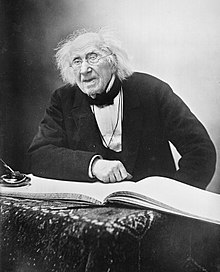Michel-Eugène Chevreul
| Michel Eugène Chevreul | |
|---|---|

Michel Eugène Chevreul
|
|
| Born | 31 August 1786 Angers, France |
| Died | 9 April 1889 (aged 102) Paris, France |
| Nationality | French |
| Known for |
Fatty acids Margarine |
| Awards |
Copley Medal (1857) Albert Medal (1873) |
| Scientific career | |
| Fields | Chemistry |
Michel Eugène Chevreul (31 August 1786 – 9 April 1889) was a French chemist whose work with fatty acids led to early applications in the fields of art and science. He is credited with the discovery of margaric acid, creatine, and designing an early form of soap made from animal fats and salt. He lived to 102 and was a pioneer in the field of gerontology. He is also one of the 72 people whose names are inscribed on the Eiffel Tower; of those 72 scientists and engineers, Chevreul was one of only two who were still alive when Eiffel planted the French Tricolor on the top of the tower on 31 March 1889.
Chevreul was born in the town of Angers, France, where his father was a physician. Chevreul's birth certificate, kept in the registry book of Angers, bears the signature of his father, grandfather, and a great-uncle, all of whom were surgeons.
At around the age of seventeen Chevreul went to Paris and entered L. N. Vauquelin's chemical laboratory, afterwards becoming his assistant at the Muséum national d'histoire naturelle (National Museum of Natural History) in the Jardin des Plantes. In 1813 Chevreul was appointed professor of chemistry at the Lycée Charlemagne, and subsequently undertook the directorship of the Gobelins tapestry works, where he carried out his research on colour contrasts. (In 1839, he published the results of his research under the title De la loi du contraste simultané des couleurs; It was translated it into English and published in 1854 under the title The Principles of Harmony and Contrast of Colors.) In 1826 Chevreul became a member of the Academy of Sciences, and in the same year was elected a foreign member of the Royal Society of London, whose Copley Medal he was awarded in 1857. In 1829, he was elected a foreign member of the Royal Swedish Academy of Sciences and a Foreign Honorary Member of the American Academy of Arts and Sciences in 1868.
...
Wikipedia
